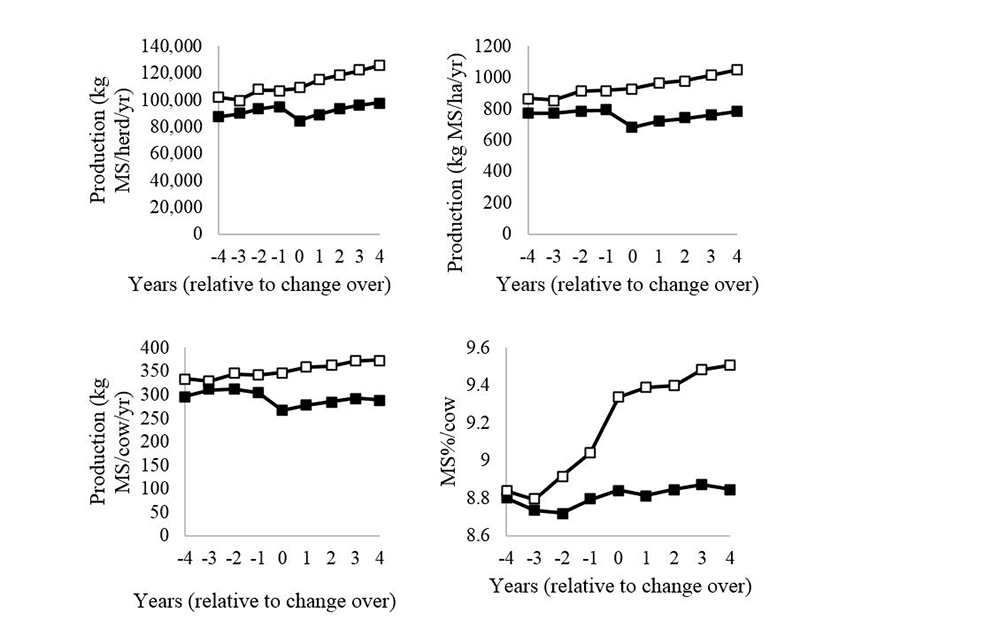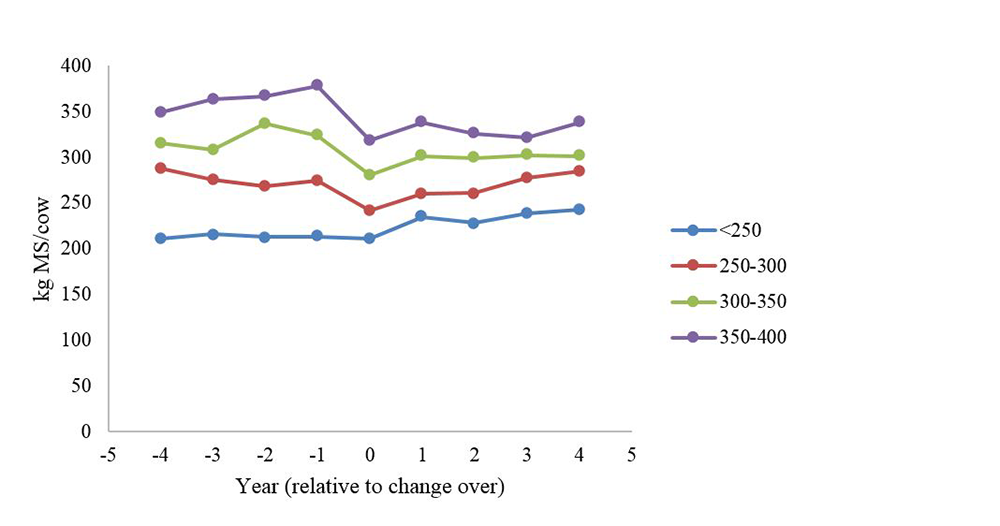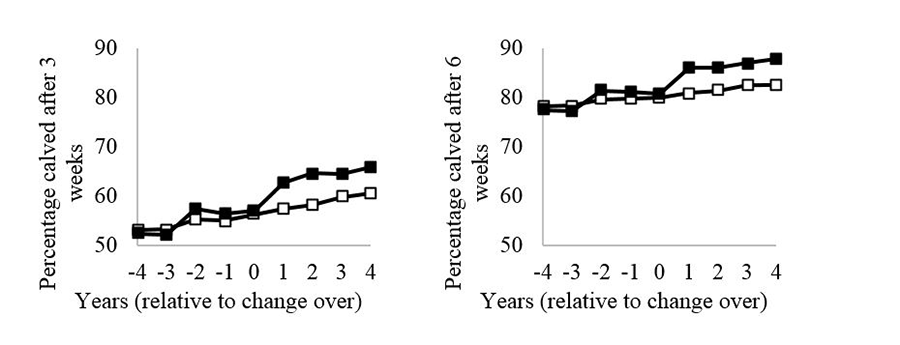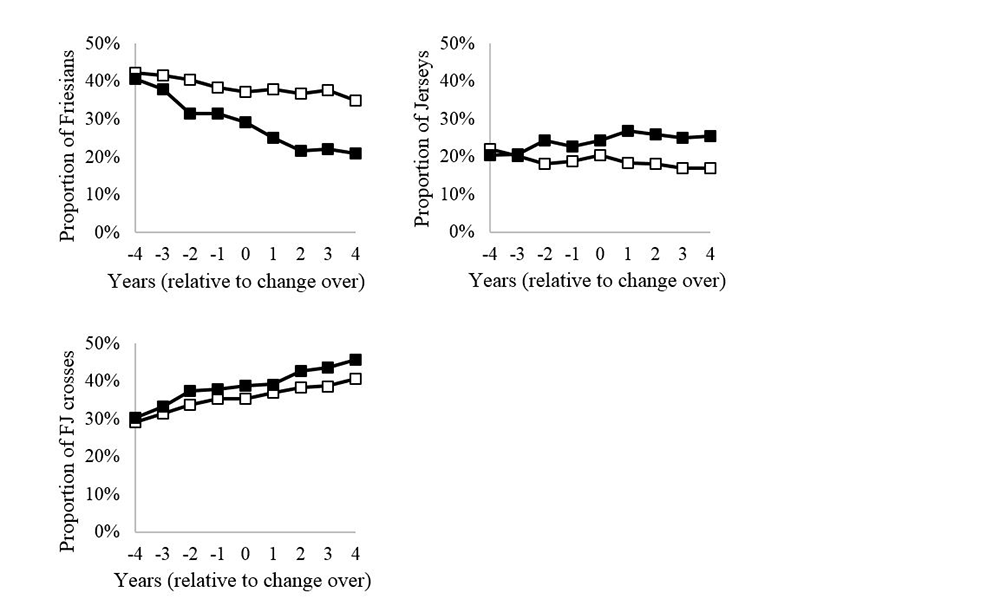Full season once-a-day (OAD) milking
13 min read
This page outlines the potential benefits of switching to full-season once-a-day (OAD), such as labour flexibility, increasing herd size, reducing energy requirements, and improving grazing management. It also highlights the considerations to keep in mind, including the importance of planning, potential production losses, and the various financial and environmental implications of making the switch. By assessing these factors carefully and understanding the potential changes in profitability and management practices, you can make an informed decision about whether OAD milking is right for your farm.
Successfully switching to full season once-a-day (OAD) milking requires planning and an evaluation of your farm system.
Milking is a time-consuming task; it typically accounts for more than half of the labour hours on New Zealand dairy farms. Halving the number of milkings may increase the attractiveness of the job (more flexible working hours) and increase the pool of labour available by employing part-time workers.

Farm considerations
Managing capital constraints:
Reducing energy requirements and lameness from walking:
Minimising cow wastage:
Improving grazing management:
Labour considerations
Increasing labour flexibility:
More productive use of the rest of the day; tasks not interrupted by an afternoon milking
Potential for 24hr grazings (i.e., no animal work till next morning)
Can handle more cows per full time equivalent (FTE)
Accessing new labour pools (e.g., milking can occur at any time during the day)
Improving staff satisfaction:
Lifestyle benefits:
Data from the Dairy Industry Good Animal Database (DIGAD) and levy milksolids database has been used to compare some of the physical differences between herds milking OAD and paired geographically similar herds milking twice-a-day (TAD), giving you an idea of what you can expect after making the switch.
The results are an association analysis so cause and effect relationships cannot be determined but they do give insight into what OAD farmers have changed along with milking frequency relative to their TAD peers.
Herds milked OAD had more concentrated milk, lower milk volume and higher SCC.

Once-a-day (black square) performance before (year -4 to -1) and after adopting OAD (year 0 to 4) relative to paired TAD herds (white square).

Productivity (kg MS/cow) before and after adopting full season once-a-day milking.
In general, OAD herds had better reproductive results than their paired TAD herds.
Note: with more cows calving earlier there will be an increase in feed demand in early spring if planned start of calving is not changed.

Comparison of 3 and 6 week calving rates between OAD (black square) and paired TAD herds (white square).
Herds milked OAD had a similar age structure, and replacement rate to TAD herds but the removal reasons differed.
It is important to note that when a farmer removes an animal from the herd only one reason can be selected, so if the animal was both empty and a low producer then it may have been recorded as a low producer. The default reason is “other” and many farmers had not selected the specific removal reason.
If a production drop is expected when adopting OAD, costs must be removed from the farm business to retain an equivalent level of profitability.
There is limited data available on OAD in DairyBase. Using data from the 2013/14 and 2014/15 seasons the following observations are made:
| KPI's | TAD | OAD | P value | Difference |
| Stocking rate (cows/ha) | 2.8 | 2.8 | 0.27 | -2% |
| Kg Milksolids/ha | 1159 | 975 | <0.0001 | -16% |
| Kg Milksolids/cow | 402 | 339 | <0.0001 | -16% |
| Cows/FTE | 139 | 157 | 0.00 | +12% |
| Gross Farm Revenue/ha | $8,738 | $7,490 | 0.00 | -14% |
| Operating expenses/ha | $6,285 | $5,589 | 0.00 | -11% |
| Operating profit/ha | $2,446 | $1,839 | 0.00 | -25% |
| Operating return on Dy Assets % | 6.0% | 5.0% | 0.23 | -16% |
Economic and farm system comparison between OAD and TAD herds from DairyBase in 2013/14 and 2014/15. Differences are statistically significant if the P value is less than 0.05.
Another dataset was published in 2007 that compared the financial performance of 22 farms that have switched from TAD to full season OAD milking. The authors of this paper reported:
The full paper ‘Can you make money milking OAD’ can be read below.
Modelling was done using Farmax and Overseer to predict the physical and environmental implications of adopting full season OAD milking (nitrogen leaching and greenhouse gas (GHG) emissions). Scenarios were evaluated in four regions; Northland, Waikato, West Coast and Southland.
Three scenarios were compared to a base farm that was typical for the region.
Scenario 1: 10% predicted production loss when switching to OAD (e.g. what could be expected in the first year OAD).
Scenario 2: 10% increased stocking rate to compensate for production drop in Scenario 1.
Scenario 3: Maintaining same production, with a shift in breed (e.g. what could be expected in the 4th season of OAD).
Results varied by region, however the following general observations were made:
Careful planning and preparation during the final season on twice-a-day (TAD) are important to making a successful transition and minimise adverse effects in year one of OAD.
Source: Lower North Island OAD discussion group

Comparison of breed between OAD herds (black square) before (year -4 to -1) and after adopting OAD (year 0 to 4) and paired TAD herds (white square).
Decreased milk production per cow during the first season of OAD reduces the feed requirement of the cow. To ensure maximum pasture utilisation stocking rate may be increased but this should be done with caution.
Stocking rate
In the first year or two on OAD, an increase in cows/ha (by 5 to 10%) is often recommended to compensate for culling unsuitable animals, the expected decreases in pasture eaten per cow and milk produced per cow.
If you were overstocked on TAD, i.e. minimal/no spring surplus and consistent low grazing residuals, no increase in stocking rate may be required.
After the first season or two on OAD and unsuitable cows have been culled and per cow production begins to increase it may be no longer necessary to carry additional cows.
You will quickly know if you have got your stocking rate wrong:
Another consequence of stocking rate being too high is the likely decrease in pasture intake and yield per cow. In this case, milksolids yield per cow would be depressed by OAD and by underfeeding.
So, any increase in stocking rate should be calculated carefully, to ensure that there will be enough cows on-farm to enable early culling and to fully utilise the pasture without over-stocking the farm.
Pasture surplus
If you initially opt not to increase stocking rate and find you have excess feed you will need to decide what to do with it:
Grazing management
Cows milked OAD can be successfully managed with either 12 or 24 hour grazing. The key determinant of which you choose will be paddock size and personal preferences.
On farms with a large range in paddock sizes OAD increases the flexibility of when cows can be moved during the day, potentially making it easier to achieve target grazing residuals. Alternatively, some farmers don’t want the hassle of moving cows in the afternoon so choose 24 hour grazing.
Quality and quantity of feed on offer is of greater importance.
Pasture management for cows milked OAD is critical to the success of the system. Any mistakes with feeding will quickly be seen in the vat and are often difficult to correct.
Winter grazing
Cows milked OAD generally dry off in better condition than TAD cows. If you are purchasing winter grazing do so on a kg DM/head/day basis not per cow/week. This way you can specify the level of feeding required and will not be paying for feed you don’t need.
On OAD, udders are likely to be at maximum capacity. Therefore, during milking, the rate of milk flow through the milking machine will be faster than on TAD. These conditions may necessitate some changes in the machine.
Cows milked OAD take longer to milk – approximately two minutes. If milking is already taking 3+ hours you may need to reconsider staff tasks to ensure milkers don’t become fatigued during the milking process i.e. staff swapping roles half way through milking. In herringbone dairies slow milkers may need to be managed separately to prevent every row being delayed.
Cows milked OAD or TAD are at a similar level of risk of developing new infections. Milking OAD does not by itself increase the risk of mastitis.
After cups-off, it is not possible to inspect the teats/udders closely for the next 24 hours, a much longer time period than on TAD. This longer inter-milking interval may enable mastitis infections to become more firmly established before the next milking.
Somatic cell count
Cows milked OAD have a somatic cell count (SCC) that can be twice as high as cows milked TAD.
This difference starts to show up once cows have moved beyond peak lactation (weeks 6-8 after calving) and remains until the end of lactation. There is likely to be greater increases in SCC during the second half of lactation, which may require high SCC cows to be dried off early.
Dairy farms have shown that it is possible to supply high quality, low somatic cell count milk in spite of OAD milking. The best way of achieving this is to keep SCC low in first half of lactation, meaning days in milk can also be maximised.
Preventing mastitis on OAD
Detecting and treating mastitis on OAD
Detection by regular herd testing and use of SCC information is an important tool for keeping your SCC levels within appropriate levels.
Cows with high SCC should be checked for mastitis by stripping out the foremilk and examining for visual signs, or by using the Rapid Mastitis Test (RMT) or by testing foremilk conductivity.
Advice on sub-clinical treatment options should be sought from your local veterinarian.
Treat clinical mastitis as you would a cow being milked TAD. Antibiotic treatments with 12 hr treatment intervals should be avoided. Consult your veterinarian for drugs more suited to OAD, including 48 hour treatments.
Withholding times
If a product is not registered for OAD milking, use the number of milkings recommended for TAD. For example, if 48 hours and four milkings recommended on TAD, then use four milkings, or 96 hours, on OAD; that is, the withholding time on OAD will be twice as long as for TAD. Consult your veterinarian for drugs with shorter withholding periods.
Milking OAD can bring some additional herd management considerations.
Calving
Cows can be milked OAD from the day they calve. Fonterra’s rules state that colostrum from each cow should be withheld from the vat for at least 8 milkings, equivalent to four days for herds milked TAD.
While the newly-calved cow is still in the colostrum herd, check all quarters/cows with the Rapid Mastitis Test (RMT). Do not put a cow’s milk into vat unless RMT indicates a low SCC.
It is advisable to inspect newly-calved colostrum-cows twice a day, to minimise losses e.g. from milk fever. If dusting pastures in wet weather e.g. with magnesium chloride, do it twice a day.
Mating
With cows only visiting the dairy once daily there is less chance to observe heats during mating. Most OAD farmers use tail paint to assist with detection of cows on heat. Some use scratch pads as an additional device.
Some OAD farmers observe cows and their tail paint for signs of heat only at the one milking per day, while some also observe the cows while they are undisturbed in the paddock.
Video 14:08 min
Video 10:02 min
Now’s the perfect time to check in, plan, and set up for a strong season. We’ve pulled together smart tips and tools to help you stay ahead all winter long.
Whether you prefer to read, listen, or download handy guides, we’ve got you covered with trusted tools to support your journey every step of the way.